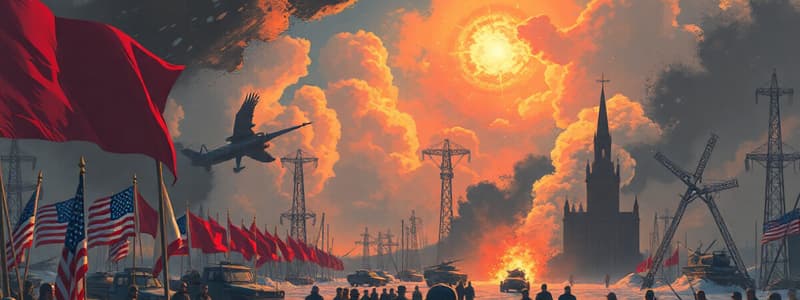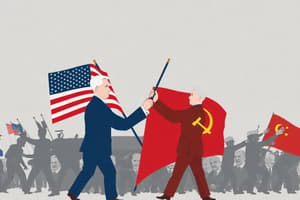Podcast
Questions and Answers
What is the main reason for the initiation of the Cold War?
What is the main reason for the initiation of the Cold War?
- The US intended to overthrow communist governments globally.
- The USSR aimed to install communist governments in Eastern Europe. (correct)
- The US and the USSR shared a common ideology after WWII.
- The USSR wanted to create alliances with Western Europe.
What does the term 'Iron Curtain' refer to in the context of the Cold War?
What does the term 'Iron Curtain' refer to in the context of the Cold War?
- The division of Europe between communist and democratic countries. (correct)
- A propaganda campaign initiated by the US.
- The economic strategies used in the US and USSR.
- A military alliance formed by the USSR.
What was the primary objective of the Marshall Plan?
What was the primary objective of the Marshall Plan?
- To discourage European countries from aligning with the US.
- To establish military bases in Europe.
- To promote communism in Western Europe.
- To aid in the reconstruction of Europe post-WWII. (correct)
Which event most significantly showcased the tensions between the East and the West?
Which event most significantly showcased the tensions between the East and the West?
What was one of the consequences of the Soviet Union's actions in Eastern Europe post-WWII?
What was one of the consequences of the Soviet Union's actions in Eastern Europe post-WWII?
Which allied approach was adopted by the United States to strengthen its position in Western Europe?
Which allied approach was adopted by the United States to strengthen its position in Western Europe?
Who coined the term 'Cold War'?
Who coined the term 'Cold War'?
What was the fear of the United States regarding the USSR's control over Eastern Europe?
What was the fear of the United States regarding the USSR's control over Eastern Europe?
What marked the beginning of enmity between the United States and Russia?
What marked the beginning of enmity between the United States and Russia?
What was a primary reason for the Cold War according to the content?
What was a primary reason for the Cold War according to the content?
Which military alliance was established to counter Soviet aggression in Western Europe?
Which military alliance was established to counter Soviet aggression in Western Europe?
What was the goal of the Marshall Plan?
What was the goal of the Marshall Plan?
What was COMECON established to counteract?
What was COMECON established to counteract?
What division characterized the geopolitical landscape during the Cold War?
What division characterized the geopolitical landscape during the Cold War?
Which country was aligned with the Soviet Union during the Cold War?
Which country was aligned with the Soviet Union during the Cold War?
Why did the United States refuse to recognize the Soviet Union until 1933?
Why did the United States refuse to recognize the Soviet Union until 1933?
What major event catalyzed a decline in U.S.-Soviet relations post-World War II?
What major event catalyzed a decline in U.S.-Soviet relations post-World War II?
What statement describes capitalism as stated in the content?
What statement describes capitalism as stated in the content?
What was a significant Eastern bloc strategy to strengthen their post-war economies?
What was a significant Eastern bloc strategy to strengthen their post-war economies?
What characterized the ideological conflict after the defeat of Hitler?
What characterized the ideological conflict after the defeat of Hitler?
How did Lénine view the survival of communism in a capitalist world?
How did Lénine view the survival of communism in a capitalist world?
What was one effect of capitalist fears regarding communism during the Cold War?
What was one effect of capitalist fears regarding communism during the Cold War?
Flashcards
The Cold War
The Cold War
A period of strategic and political tension between the United States and its Western allies, and the Soviet Union and its allies following World War II.
Origin of the term "Cold War"
Origin of the term "Cold War"
The term "Cold War" was first used by American journalist Herbert Bayard Swope in a 1947 speech.
Soviet Expansion and the Cold War
Soviet Expansion and the Cold War
The Soviet Union's actions to establish communist governments in Eastern Europe, despite agreements to allow free elections at the Yalta Conference, sparked the Cold War.
Iron Curtain
Iron Curtain
Signup and view all the flashcards
Marshall Plan
Marshall Plan
Signup and view all the flashcards
Cold War Confrontations
Cold War Confrontations
Signup and view all the flashcards
Soviet Justification for Expansion
Soviet Justification for Expansion
Signup and view all the flashcards
Ideological Conflict of the Cold War
Ideological Conflict of the Cold War
Signup and view all the flashcards
Capitalism
Capitalism
Signup and view all the flashcards
Communism
Communism
Signup and view all the flashcards
Cold War
Cold War
Signup and view all the flashcards
COMECON (Council for Mutual Economic Assistance)
COMECON (Council for Mutual Economic Assistance)
Signup and view all the flashcards
NATO (North Atlantic Treaty Organization)
NATO (North Atlantic Treaty Organization)
Signup and view all the flashcards
Warsaw Pact
Warsaw Pact
Signup and view all the flashcards
Rise of the Soviet Union
Rise of the Soviet Union
Signup and view all the flashcards
Soviet Control of Eastern Europe
Soviet Control of Eastern Europe
Signup and view all the flashcards
Cold War (Second Definition)
Cold War (Second Definition)
Signup and view all the flashcards
East vs West
East vs West
Signup and view all the flashcards
Communist Expansionism
Communist Expansionism
Signup and view all the flashcards
China's Role in the Cold War
China's Role in the Cold War
Signup and view all the flashcards
China's Historical Relations with the West
China's Historical Relations with the West
Signup and view all the flashcards
Ideological Conflict
Ideological Conflict
Signup and view all the flashcards
Study Notes
The Cold War: A Summary
- The Cold War was a period of strategic and political conflict between the US and its Western European allies, and the USSR and its communist allies, following World War II.
- The term "Cold War" originated with American journalist Herbert Bayard Swope in a 1947 speech.
- The conflict began when the USSR used its military power to establish communist governments in Eastern Europe, violating agreements made at the Yalta Conference which promised free elections in Soviet-dominated countries after WWII.
- The US saw this as a threat, believing its future was tied to the fate of European countries, and feared Soviet expansion to Western Europe.
- The USSR, suffering immense losses in WWII, sought to strengthen itself by controlling its neighbours. The "Iron Curtain" symbolized this division.
- The USSR believed imposing communism on neighbouring countries was necessary for its survival and to counter its isolation against the US and its allies.
- The US formed alliances with Western Europe through the Marshall Plan, aiming to rebuild Europe's strength and increase US influence. The Marshall Plan also aimed to make Western European countries indebted to the US, strengthening the alliance.
- The East-West conflict played a significant role in future global conflicts, including the struggle for Germany, Korean War and the Cuban Missile Crisis.
Origins of the Cold War
- US-Soviet relations, previously amicable for over a century, progressively deteriorated, culminating in the 1917 Bolshevik Revolution which established the Soviet Union and its ideological clash with capitalist Western countries..
- The US refused to recognize the USSR as a state until 1933.
- While allies during WWII, US-Soviet relations sharply declined from 1944 onwards, reaching a breaking point after Joseph Stalin violated the Yalta agreements by controlling Eastern European countries and preventing democratic elections.
- The Soviet actions were motivated by a desire to maintain communism's global survival in the face of capitalist powers' attempts to dismantle the system.
- Lenin had envisioned expanding communism globally to counter the threat of capitalism.
- The constant fear of communist expansion motivated a strong response from capitalist countries, putting the world on the brink of nuclear war.
The Cold War's Two Blocks
- The Cold War divided the global community into two opposing blocs: the communist East (led by the USSR) and the capitalist West (led by the US).
- Each bloc had its own political, economic, and military interests to defend.
- Later, China joined the communist bloc, creating a significant communist power bloc of over a billion people.
- The Sino-Soviet alliance was not coincidental. Decades of strained relations with capitalist powers motivated China's intervention, stemming from a perceived historical inequity.
- China's hostility towards the US was intense, surpassing even earlier tensions with the USSR due to historical grievances over exploitation and lack of respect from capitalist countries.
Economic and Military Rivalries
-
West:
-
Capitalism: An economic system emphasizing private enterprise, where individuals own and control production.
-
Marshall Plan: A US initiative (1948) providing $13 Billion in aid to rebuild war-torn Western European economies.
-
NATO: A defensive military alliance (1949), intended to counter potential Soviet aggression. Initial members included the US, Canada, and several Western European nations.
-
East:
-
Communism: A centralized economy where the state controls production.
-
COMECON: A Soviet-led economic organization (1949) countering the Marshall Plan, fostering economic cooperation among communist countries. Member countries included Eastern European nations like Poland, Hungary, and Czechoslovakia.
Studying That Suits You
Use AI to generate personalized quizzes and flashcards to suit your learning preferences.




